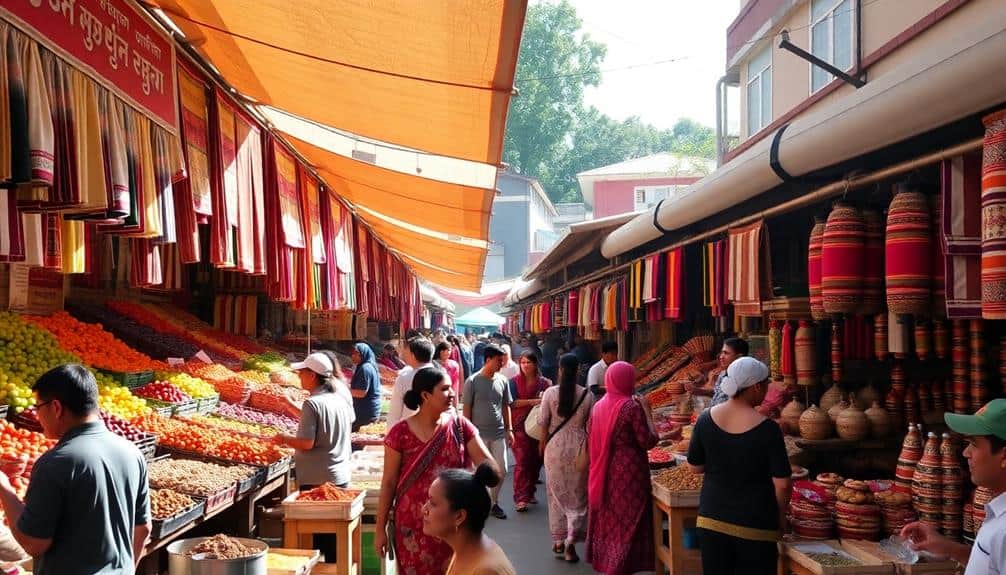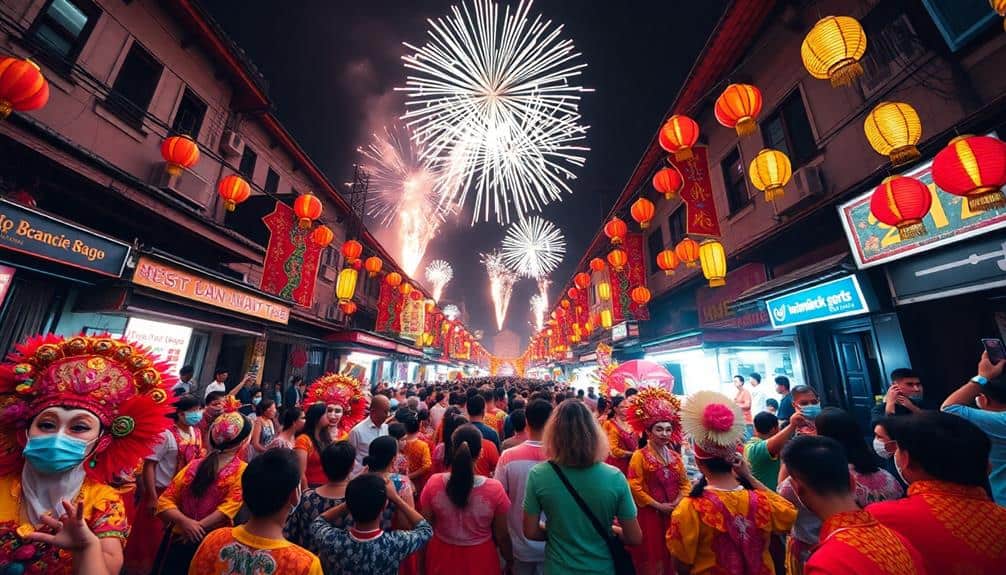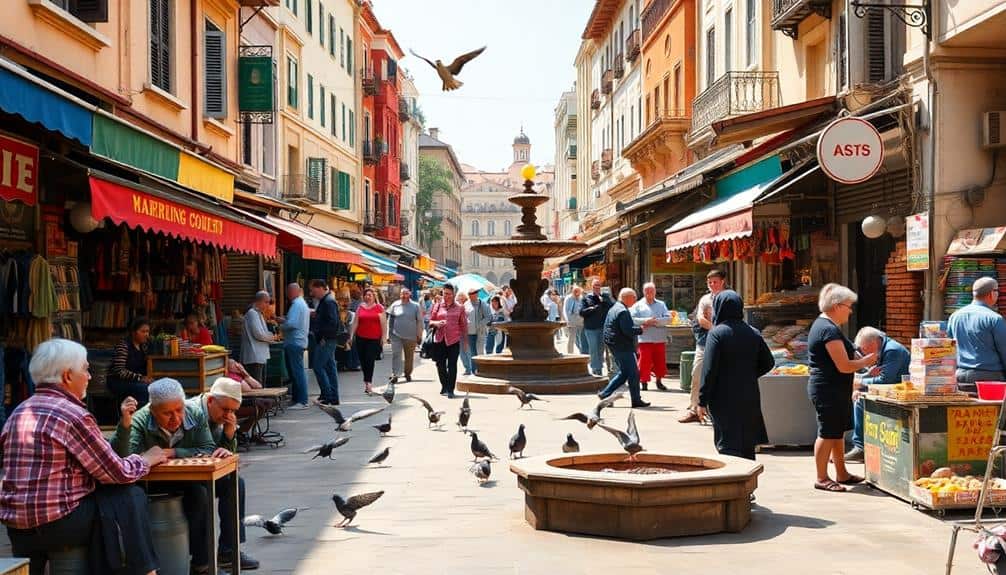
3 Ways to Photograph Local Culture While Traveling
To capture local culture while traveling, focus on three key areas. First, photograph local markets and vendors, using wide-angle lenses to showcase the atmosphere and colorful displays. Second, document traditional festivals and celebrations, positioning yourself strategically to capture vibrant costumes and unique rituals. Third, observe everyday life and interactions in public spaces, using telephoto lenses for discreet shots or wide-angle lenses for broader context. Adjust your camera settings to accommodate varying lighting conditions and use a travel tripod for stability. Pay attention to cultural nuances in gestures, clothing, and transportation. By exploring these aspects, you'll create an all-encompassing visual narrative of your destination's rich cultural tapestry.
In a Nutshell
- Explore local markets to capture vibrant displays, vendor interactions, and authentic cultural experiences.
- Document traditional festivals and celebrations, focusing on costumes, performances, and unique rituals.
- Photograph everyday life in public spaces to showcase local routines, customs, and social interactions.
- Adjust camera settings for various lighting conditions and use appropriate lenses for different scenarios.
- Research and plan ahead to position yourself strategically for capturing key cultural moments and events.
Photograph Local Markets and Vendors

When you're aiming to capture the essence of local culture, markets and vendors offer a vibrant, bustling environment ripe with photographic opportunities. To make the most of these settings, use a wide-angle lens to capture the scope and atmosphere of the market. Focus on details like colorful produce displays, handcrafted goods, and the interactions between vendors and customers. Consider using a fast shutter speed to freeze motion in busy scenes, or experiment with slower speeds to convey movement and energy. Pay attention to lighting conditions, as indoor markets may require higher ISO settings or a wider aperture. Comfort is essential when spending hours exploring markets, so wear lightweight, breathable shoes to keep your feet cool and supported during long walks. This will help you stay focused on capturing the perfect shot without discomfort. Don't forget to ask permission before photographing individuals, and be respectful of local customs. Capture candid moments that tell a story, such as a vendor arranging their wares or a customer examining products. These images will provide a genuine glimpse into daily life and local traditions.
Capture Traditional Festivals and Celebrations

Festivals and celebrations offer a treasure trove of photographic opportunities for capturing local culture. To make the most of these events, research the festival's schedule and key moments in advance. Position yourself strategically to capture the essence of the celebration, focusing on vibrant costumes, traditional performances, and unique rituals. Use a fast shutter speed to freeze dynamic movements, and consider a wide-angle lens to encompass the entire scene. To guarantee stability and crisp images, especially in low-light conditions, consider using a travel tripod for your camera. This will help you capture sharp, clear photos even during nighttime festivities. Don't shy away from photographing candid moments of participants and spectators, as these often convey genuine emotions. Adjust your camera settings to accommodate changing lighting conditions, particularly for nighttime events with fireworks or lantern releases. Be respectful of local customs and always ask permission before photographing individuals. Remember to capture both the grand spectacles and intimate details that define the festival's cultural significance.
Document Everyday Life and Interactions

Delving into the heart of local culture, documenting everyday life and interactions offers a genuine glimpse into a community's essence. Seek out public spaces like markets, parks, and cafes, where locals naturally congregate and go about their daily routines. Capture candid moments of people working, shopping, or socializing to showcase authentic slice-of-life scenes. Focus on subtle details that reveal cultural nuances, such as hand gestures, clothing styles, or modes of transportation. When photographing individuals, always ask for permission and respect local customs regarding privacy. Use a telephoto lens for discreet shots from a distance, or a wide-angle lens to capture broader scenes that include environmental context. Pay attention to lighting conditions throughout the day, as they can dramatically affect the mood and atmosphere of your images. Consider using a compact clothesline to dry and freshen your clothes between photo sessions, ensuring you look presentable while blending in with locals. This approach allows you to immerse yourself more fully in the culture you're documenting, as you'll spend less time worrying about laundry and more time capturing authentic moments.
Frequently Asked Questions
How Can I Respectfully Photograph Religious Ceremonies or Sacred Sites?
When photographing religious ceremonies or sacred sites, you'll need to be mindful and respectful. Always seek permission from local authorities or religious leaders before capturing images. Be discreet, using silent shutter modes and avoiding flash photography. Maintain a respectful distance, and don't disrupt rituals or worshippers. Dress modestly and follow any specific rules or customs. Consider learning about the cultural significance of the site or ceremony beforehand. Remember, some places may prohibit photography entirely, so always be prepared to put your camera away.
What Camera Settings Work Best for Low-Light Cultural Performances?
Did you know that 85% of cultural performances occur in low-light conditions? To capture these moments, you'll want to use a wide aperture (f/2.8 or wider) to let in more light. Set your ISO between 1600-3200, balancing noise with brightness. Opt for a slower shutter speed, around 1/60s, to maintain sharpness while allowing enough light. If possible, use a lens with image stabilization. Consider shooting in RAW format for more flexibility in post-processing, especially when dealing with challenging lighting situations.
Are There Legal Considerations When Photographing People in Different Countries?
When photographing people in different countries, you'll need to be aware of varying legal requirements. Some nations have strict privacy laws that prohibit taking photos without consent, while others are more lenient. You should research local regulations before your trip, as penalties can range from fines to arrest. In many cases, it's best to ask permission before photographing individuals, especially in private settings. Be particularly cautious when photographing children, religious sites, or government buildings, as these often have additional restrictions.
How Do I Approach Locals for Portraits Without Seeming Intrusive?
Like a butterfly approaching a delicate flower, you'll need to be gentle and respectful when seeking portraits of locals. Begin by learning a few key phrases in the local language, as this shows respect and effort. Spend time in the community, allowing people to become familiar with your presence. When you're ready to ask, approach individuals with a warm smile, explain your purpose clearly, and always ask for permission. Be prepared to accept refusals graciously, and offer to share the photos if they agree.
What Editing Techniques Can Enhance Cultural Photos Without Misrepresenting the Subject?
When editing cultural photos, you'll want to enhance without distorting reality. Subtle adjustments to contrast, saturation, and white balance can improve visual impact while maintaining authenticity. Use selective editing to highlight key elements, such as traditional clothing or architecture. Avoid over-processing or applying heavy filters that may misrepresent skin tones or cultural artifacts. Instead, focus on techniques that preserve the natural atmosphere and cultural context, such as gentle color grading to emphasize local light conditions or careful cropping to improve composition.
